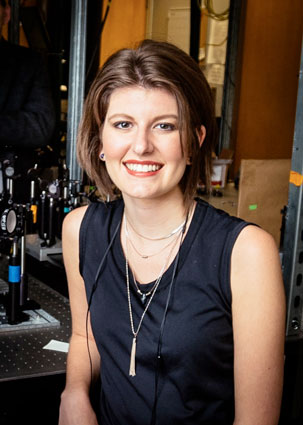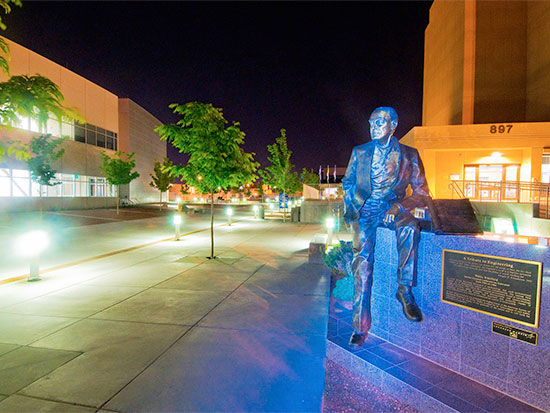 Ashlyn BurchThe fourth year of graduate school for Ashlyn Burch will be great — except it takes place 1,250 miles away from UAB’s Campus Green.
Ashlyn BurchThe fourth year of graduate school for Ashlyn Burch will be great — except it takes place 1,250 miles away from UAB’s Campus Green.
For 12 months, the University of Alabama at Birmingham physics student will work at Sandia National Laboratory, high in the semi-arid Western city of Albuquerque, New Mexico, supported by a U.S. Department of Energy Science Graduate Student Research award.
Her experiments will tackle one of the great unanswered questions of physics — how “high-temperature” superconductors work. At the same time, she will keep up with her weekly UAB lab group meetings via social media.
Superconductivity was discovered a century ago, when researchers found that some materials suddenly could carry an electrical current with zero electrical resistance when cooled close to absolute zero. The theory explaining this incredible phenomenon came 40 years later, from three physicists who later shared a Nobel Prize.
Their theory, however, has failed to explain the next important group of superconducting materials — the so-called “high-temperature” superconductors. These materials — first described about 30 years ago — make the transition to superconductivity at temperatures above the boiling point of liquid nitrogen. This is a much higher temperature than the early superconductors, and it holds promise for possible commercial applications.
Promise, that is, if physicists can learn how the high-temperature superconductors work. They need that knowledge to help design new materials that are more easily fabricated and can carry large current loads.
Voyage of exploration
Last month, Burch drove cross-country to begin her DOE research at Sandia — a year of ultrafast magneto-spectroscopy.
Her research in New Mexico will be a voyage of exploration, using advanced technology to force cuprate and nickelate materials into non-equilibrium phases, in order to tease out clues about high-temperature superconductivity.
In collaboration with Los Alamos National Laboratory researcher Rohit Prasankumar, Ph.D. —who has a lab at Sandia — Burch will target one-third-inch cuprate and nickelate specimens with laser light, while varying the magnetic field around the specimens up to 7 Tesla.
An analogy may be the best way to explain this experimental approach, says Burch’s UAB adviser, David Hilton, Ph.D., associate professor of physics in the College of Arts and Sciences.
“To understand how a car engine works,” Hilton said, “I would give you one and tell you to take it apart.” Wielding wrenches and screwdrivers, you would begin to understand how all the parts connect and work together.
“With the superconductors, we use the light to make materials do what they don’t want to do,” Hilton said. At the same time, Burch and Hilton can also vary the temperatures between superconductivity and non-superconductivity, and they can use powerful magnets that can quench superconductivity. These tools force the materials into non-equilibrium phases, and under those conditions, Burch and Hilton can ask:
- At what temperature does superconductivity fall apart?
- At what wavelength of light does it fall apart?
- At what magnetic field does it stop?
 Sandia National LaboratoryChallenged to think
Sandia National LaboratoryChallenged to think
Some students might hesitate to spend a year at a distant campus like Sandia National Laboratory, but Burch has traveled far afield as a youth and during college.
For 13 years growing up, she lived in Russia with her Baptist missionary parents and family. She learned to speak Russian with a St. Petersburg accent and took her schooling online through private Christian school NorthStar Academy.
“When I was in high school, I fell in love with physics,” Burch said. “It was the first thing that challenged me academically. I love studying things that you can’t see, and physics is really mysterious. The more answers you find, the more questions there are.”
During undergraduate studies at Georgia College, Burch spent one summer at CERN, the largest particle physics laboratory on the planet. Located on the France-Switzerland border, CERN includes the world’s largest and most powerful particle accelerator, a 16.5-mile ring of superconducting magnets 330 feet underground.
“I loved it,” Burch said of that National Science Foundation Research Experiences for Undergraduates experience. “But the scope of the project was so large. I wanted to work on a project where I felt I was part of it. Also, I wanted to work on a project that was directly applicable to society.”
Her Georgia College professor suggested a visit to the Ph.D. physics program in the UAB Graduate School. Burch found that she “loved the research Dr. Hilton does, working with magnets and lasers to study materials under extreme conditions.”
Experience at UAB
Burch calls Hilton “a really cool guy. He is very understanding of where you are in life, and his goal is to push you to be the best you can be.” Hilton also pushes students to do a lot of work in the lab because it helps them understand physics concepts.
In her first three years at UAB, Burch made several trips to Tallahassee, Florida, as part of the team doing terahertz spectroscopy on the one-of-its-kind 25 Tesla Split Florida-Helix Magnet at the National High Magnetic Field Laboratory.
Each field trip was arduous. Burch and her Hilton lab colleagues usually had magnet times from 3 p.m. to 2 a.m., each day for a week, and they could use up to 480 megawatts of power. After each late night, “we were up at 6 or 7 a.m. the next day, because the experiment constantly had to be realigned,” Burch said. “During testing, we would get three or four hours of sleep a night.”
When Burch returns to Birmingham next year for her final year of graduate school, she will make more research trips to the 25 Tesla Split Florida-Helix Magnet in Tallahassee, and she will write her Ph.D. thesis.
“My parents support me and are very proud of me,” Burch said of her UAB graduate studies, “even though they may not understand everything about what I do.”